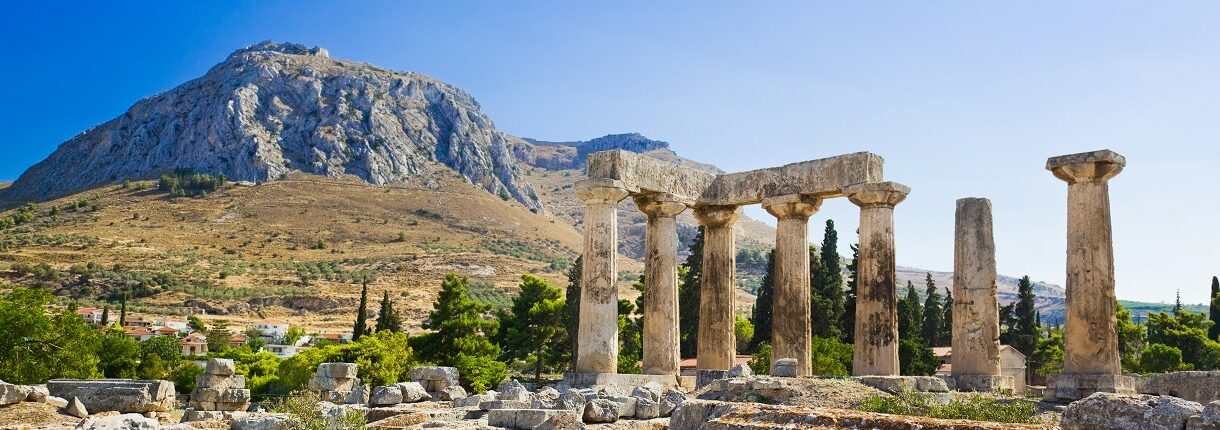 Wine Toursfrom 149 € per person
Wine Toursfrom 149 € per person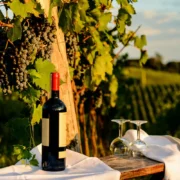

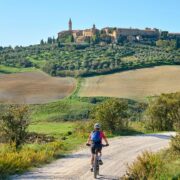 > BOOK Wine Tours and experience walks through vineyards, wine tastings, medieval villages, olive oil and cooking classes, a unique blend of tours to immerse yourself in the heart of Tuscany. > Check all Wine Tours
> BOOK Wine Tours and experience walks through vineyards, wine tastings, medieval villages, olive oil and cooking classes, a unique blend of tours to immerse yourself in the heart of Tuscany. > Check all Wine Tours
 Cooking Classesfrom 69€ per person
Cooking Classesfrom 69€ per person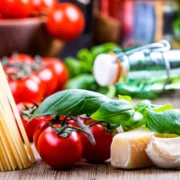


> BOOK Cooking Classes and learn how to make Pizza, Pasta, Gelato and much more… put your hands in the dough and get familiar with traditional Italian recipes – Cooking classes are fun and yummy! > Check all Cooking Classes
 Cultural Toursfrom 35€ per person
Cultural Toursfrom 35€ per person


> BOOK Cultural Tours and visit the cultural highlights of Italy: Museums, Monuments, Art Galleries, historical sites, are available in Venice, Florence, Rome, Milan, Naples, Palermo.
Walking tours, Gondola tours, bike tours, vespa tours, all with an expert tour guide. > Check all Cultural Tours
 Boat Toursfrom 59€ per person
Boat Toursfrom 59€ per person


> BOOK Boat Tours and experience a Gondola cruise in Venice or in Florence on the River Arno a blend of iconic sights, local culture, and quintessential Venetian and Florentine spirit. > Check all Boat Tours
 Food Toursfrom 45€ per person
Food Toursfrom 45€ per person

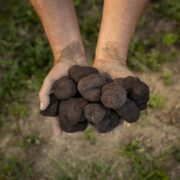
> BOOK Food Tours and visit a local food market and experience the authentic flavours of cheese, cutlets, olive oil, truffle, honey, and so much more. Participate in harvests, go truffle hunting, or visit a farm, spend time with locals and feel their customs. > Check all Food Tours
 Creative Workshopsfrom 40€ per person
Creative Workshopsfrom 40€ per person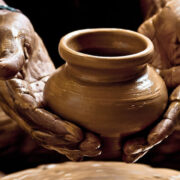
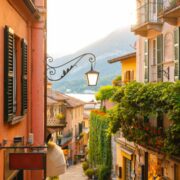

> BOOK Creative Workshops and experience painting, jewellery, pottery, sculpture, art, music, …. there are so many creative activities in Italy. Numerous artists and craftsmen like to share their passion with visitors in small workshops. > Check all Workshops
 Bike Toursfrom 35€ per person
Bike Toursfrom 35€ per person
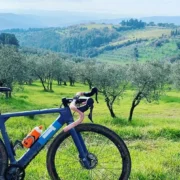

> BOOK Bike Tours and explore the Tuscan countryside or the cities by Bike or E-bike. Immerse yourself in a day filled with art, history and biking discovering unspoiled areas that are often left unexplored by mass-tourism, making your experience unique and authentic. > Check all Bike Tours
 Nature & Eco Friendlyfrom 35€ per person
Nature & Eco Friendlyfrom 35€ per person


> BOOK Eco-Friendly Tours and E-bike through the Tuscan countryside or simply explore the historic cities and marvellous villages in an eco-friendly way. Embark on a sailing boat and explore the Tuscan Archipelago combined with your daily Yoga practice. > Check all Eco-friendly Tours
 Adventure & Sportsfrom 149€ per person
Adventure & Sportsfrom 149€ per person


> BOOK Adventure Tours and experience the beauty and hidden gems of Tuscany while hiking, biking, trekking, horseback riding, sailing … Immerse yourself in a day filled with art, history, high-quality gastronomy through charming villages less travelled by tourists. > Check all Adventure Tours
TOURS IN GREECE
 Greek Island Hopping
Greek Island Hopping
Island Hopping
A lifetime is not enough to visit all the Greek islands.
Endless blue horizons, whitewashed villages, and the sound of sails in the wind. From turquoise bays to late-night tavernas, Greece serves it all: sea, sun, and soul.
View our suggestions or contact our Travel Advisors for a customised trip. Cultural Toursfrom 39€ per person
Cultural Toursfrom 39€ per person
Cultural Tours
Visit the cultural highlights of Greece!
World famous museums and archeological sites, historical monuments, art galleries, temples, heroes, myths and Gods are waiting for you!
Guided tours, walking tours, private tours in Athens, Delphi, Mycenae, Epidaurus, Meteor, Olympia, Corinth, …
 Boat Tours - Day Cruisesfrom 105€ per person
Boat Tours - Day Cruisesfrom 105€ per person
Boat Tours & Day Cruises
Experience the perfect Greek day full of relaxation, exploration, and indulgence ! Swim and snorkel in crystal coves, sail to hidden islands, and taste fresh home made food with local wines while enjoying the eternal Mediterranean sun. You will access places you simply can’t reach by road.
Island hopping (e.g., visiting 2–3 islands like Hydra, Poros, and Aegina from Athens).
Sailing excursions with swim stops and snorkeling.
Sunset cruises with wine and music.
Private yacht charters for a more personalized experiences
 Local Traditions & Dancesfrom 80€ per person
Local Traditions & Dancesfrom 80€ per person
Local Traditions & Dances
Experience a traditional night out in Athens with Bouzouki, dancing and good food. Watch (or join!) performances of traditional Greek dances like the sirtaki and kalamatianos, often accompanied by live bouzouki music and meze.
Explore the spiritual side of Greece — monasteries, Easter rituals, local saints’ feast days, and Byzantine chants.
Participate in a village festival (panigyri) with music, dancing, and slow-cooked lamb.
 Food Toursfrom 79€ per person
Food Toursfrom 79€ per person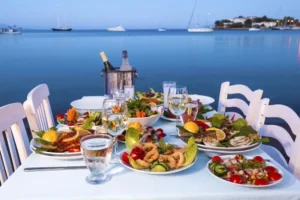
Mediterranean Food
In Greece you will find the Mediterranean Gastronomy at its finest. Visit traditional mountain or island villages, meet locals, and experience Greek hospitality (filoxenia). Dive into Greek gastronomy and its cultural roots — from ancient recipes to regional specialties passed down for generations. Includes: Market and farm visits, foraging, ouzo/raki distillery tours, and full cooking experiences, cook with a Yiayia (Greek Grandma) learn how to bake pittas and bread in wood ovens, taste olive oil, cheese-making, and more.
 Creative Workshops
Creative Workshops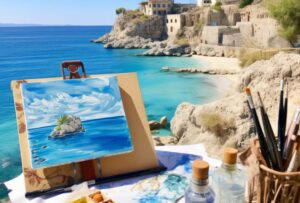
Creative Workshops
There are many creative activities to experience in Greece. Numerous artists and craftsmen like to share their passion with visitors in small workshops.
Hands-on classes with local artists — pottery, weaving, icon painting, mosaic art, or soap making using olive oil.
Insight: Learn how ancient skills still shape Greek daily life.
 Adventure & Sportsfrom 90€ per person
Adventure & Sportsfrom 90€ per person
Sailing & Water Sports
Dive into deep blue caves, hike ancient trails and adventurous gorges (e.g. the Samaria Gorge – Crete), ride waves, and climb cliffs in beautiful island spots or on the Greek mainland.
Bike or E-bike around Athens with stops at urban gardens and local tavernas or cycle along panoramic island roads, and – of course – sail among the scattered islands of the Aegean Sea and enjoy wind, sea and sun like never before.
 Nature & Eco-Friendly
Nature & Eco-Friendly
Nature & Eco Friendly
Nature offers endless experiences in Greece:
Visit natural parks and spot wildlife, learn about native flora and traditional herbal uses from local guides. Explore car-free islands like Hydra or eco-conscious routes through olive groves and vineyards. Join a sustainable sailing trip that uses wind power, avoids single-use plastics, and follows responsible anchoring practices. Take part in beach cleanups or dolphin observation with scientists. Visit organic farms, pick olives, press your own oil, or harvest grapes in family-run estates. Yoga retreats that emphasize connection with nature are available on request.
LEARN LOCAL CUSTOMS IN GREECE

Greek Coffee Tradition
The Greek Coffee Tradition: More Than Just a Drink
In Greece, coffee isn’t just a beverage—it’s a ritual, a social anchor, and an unhurried moment of connection. Whether you’re sipping it in a bustling city square or a sleepy island village, Greek coffee (ellinikós kafés) is about slowing down and savoring life.
Served in a small cup, Greek coffee is strong, unfiltered, and prepared in a briki—a tiny copper pot heated slowly over a flame or hot sand. The process is precise: finely ground coffee, cold water, and optional sugar are stirred together until they foam, but never boil. The result is a rich, velvety brew with a layer of crema on top and thick grounds that settle at the bottom (no stirring once served!).
You’ll often be asked how sweet you want it:
- Sketos (no sugar),
- Metrios (medium),
- Glykos (sweet),
- or Variglykos (very sweet)
But it’s not just about taste—it’s about time. Greeks can sit over one coffee for hours, talking politics, philosophy, or just people-watching. It’s common to see groups gathered at kafeneia (traditional cafés), where generations mix and conversations stretch long into the day. Even the fortune-telling custom of reading the coffee grounds (kafemanteia) after finishing a cup still lingers in some homes and villages.
Whether you’re catching up with friends or sitting solo with the sun on your cheeks, drinking Greek coffee is a gentle reminder: slow down, be present, and enjoy the moment.
Learn how to cook Greek coffee, how to drink it properly and how to read your future at the bottom of the cup.
Greek Language Lessons for Visitors: Speak Like a Local (Just a Little!)
Either prior or during your trip to Greece you might want to learn something more about the Greek language. While many Greeks speak English learning a few basic Greek words and phrases can go a long way. It’s a sign of respect, sparks smiles, and often opens doors to more genuine interactions. Greek might look a bit intimidating at first (thanks to its unique alphabet), but spoken Greek is surprisingly melodic and fun to try.
You don’t need to be fluent—just a few words can bring a big smile. Greeks love it when visitors try, and they’ll often help you along the way. Here are some essential words and phrases to help you feel more at home:
Basic Greetings
- Kaliméra (kah-lee-ME-ra) – Good morning
- Kalispéra (kah-lee-SPE-ra) – Good evening
- Kaliníhta (kah-lee-NEEK-ta) – Good night
- Yiá sou (YAH-soo) – Hello / Hi (informal)
- Yiá sas (YAH-sas) – Hello / Goodbye (formal or plural)
Politeness Matters
- Efharistó (eff-kha-ree-STOH) – Thank you
- Parakaló (pa-ra-ka-LOH) – Please / You’re welcome
- Signómi (seen-GNO-mee) – Excuse me / Sorry
- Nai (neh) – Yes
- Ochi (OH-hee) – No
Eating Out
- To logariasmó, parakaló? – The bill, please?
- Neró – Water
- Krasi – Wine
- Kafés – Coffee
- Kaliòrexi! – Enjoy your meal!
Getting Around
- Pou íne…? – Where is…?
- Stathmós – Station
- Paralía – Beach
- Domátio – Room
- Vriskóme hamenos/hameni. – I’m lost (male/female speaker)
Sound Like a Local
- Kefi – Joyful spirit or good vibes
- Filoxenía – Greek hospitality, love for strangers
- Yamas! – Cheers! (literally “to our health”)
Would you like a printable phrase sheet or audio pronunciation guide to practice with?
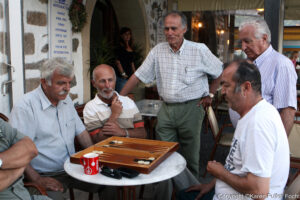
Tavli – Backgammon
Backgammon in Greece:
In Greece, tavli (τάβλι)—the Greek name for backgammon—isn’t just a game; it’s a social ritual woven into daily life. From lively seaside cafés to shady village squares, you’ll often hear the rhythmic clack of dice and the occasional triumphant shout from locals engaged in passionate matches.
Tavli is typically played between two people and comes in three main variations: Portes, Plakoto, and Fevga—all played on the same board but with different rules and strategies. Many Greeks master all three, switching versions mid-session or playing best-of-three tournaments over coffee, ouzo, or endless conversation.
The game’s appeal lies in its perfect balance of luck, skill, and banter. It’s common to see retirees, young people, and even strangers bond over a spontaneous match. There’s friendly competition, lots of teasing, and always time for another round.
Watching a tavli game in Greece feels like tapping into the heartbeat of everyday culture—slow, social, strategic, and full of personality. It’s a reminder that sometimes, the best part of a trip isn’t seeing the sights—it’s sitting still and sharing a moment of life the Greek way.
Would you like to learn the basic rules of tavli or how to join a local game while visiting?

Mati – Evil Eye Tradition
The Evil Eye in Greece: Protection with a Stare
In Greece, the mati (μάτι), or “evil eye,” is more than just a pretty blue charm—it’s a centuries-old belief that has woven itself into daily life, culture, and even fashion. Whether you spot it dangling from necklaces, hanging in homes, or painted on fishing boats, the mati is everywhere—and always watching.
The tradition stems from the belief that envy or admiration—especially if it’s intense or unspoken—can cause misfortune, bad luck, or illness. This “curse of the eye” is usually unintentional, but powerful nonetheless. The solution? Protection in the form of a blue eye amulet, said to reflect the bad energy back to its source and keep you safe.
You’ll often hear people say «faskané!» (a verbal expression to ward off the eye) or see them make a small spitting gesture (a sound more than actual spitting) to prevent bad luck after giving a compliment, especially to children or beautiful things.
For those who believe they’ve been “struck” by the eye—matiasméno—there’s even a traditional ritual of removal (xematiasma), often passed down through families. Someone who knows the prayer (usually a grandmother) recites it in secret, often over a glass of water, until the symptoms—headache, fatigue, or just “feeling off”—are said to lift.
Whether you see it as spiritual protection, cultural expression, or just a meaningful souvenir, the mati is one of the most recognizable and beloved symbols of Greece—a watchful, beautiful little guardian with ancient roots and modern charm.
Would you like to know where to buy authentic mati jewelry or gifts in Greece?
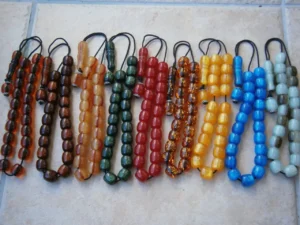 Komboloi: The Rhythmic Art of Relaxation in Greece
Komboloi: The Rhythmic Art of Relaxation in Greece
The soft click-clack of beads in hand is a familiar sound across Greece—on a quiet island street, in a bustling café, or from the hands of an old man sitting by the sea. This is the komboloi (κομπολόι), or Greek worry beads: part meditation tool, part cultural tradition, and a small but powerful symbol of everyday Greek life.
Despite their name, komboloi aren’t tied to religious use like rosaries. Instead, they’re used to pass the time, calm the nerves, or simply enjoy a pleasant rhythm. Often made of amber, glass, wood, or even coral, each komboloi is strung with an odd number of beads (often 17 or 23) and ends in a knot or tassel.
Playing the komboloi is more art than game. There are various styles:
- Quiet flicking, where beads roll between fingers.
- Rhythmic swinging, where a section of beads strikes the others in a satisfying rhythm.
- And the «louder» flip, often used for flair or stress relief, with beads hitting the palm or flipping over the back of the hand.
While traditionally more popular among older men, komboloi has become a stylish accessory and stress-relief tool for all ages. You’ll find beautiful handcrafted versions in souvenir shops and specialty stores throughout Greece, especially in cities like Nafplio and Athens.
More than just a keepsake, the komboloi is a tiny, tangible piece of Greek culture—calm, cool, and endlessly charming.
Would you like tips on how to use komboloi or where to find authentic handmade ones?
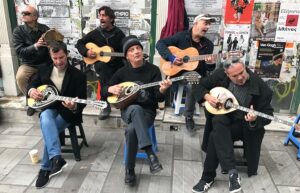 Bouzouki & Dancing: The Soulbeat of Greece
Bouzouki & Dancing: The Soulbeat of Greece
When the sun sets and the music rises, Greece truly comes alive—and at the heart of that spirit is the sound of the bouzouki. This iconic stringed instrument, with its bright, soulful twang, is the heartbeat of Greek music, especially in genres like rebetiko and laiko. Whether it’s echoing through a seaside taverna or leading a full-blown celebration, the bouzouki stirs something deep in every listener.
Its melodies are often bittersweet—joyful and melancholic all at once—telling stories of love, loss, passion, and resilience. Played with speed and flair, the bouzouki sets the rhythm for the night, inviting everyone to join in the music not just with their ears, but with their whole body.
And when the bouzouki plays, the dancing begins.
Greek dancing isn’t just performance—it’s participation. From the famous sirtaki (often mistakenly called «Zorba’s dance») to regional circle dances like kalamatianos and tsamikos, it’s all about connection. Dancers hold hands or shoulders, move in rhythmic patterns, and build intensity with each step. No experience? No problem. In Greece, if you’re near music, you’re welcome to join. Someone will pull you in, guide your steps, and before you know it, you’re laughing and spinning like a local.
Whether you’re watching a spontaneous dance break out at a taverna or clapping along at a village panigyri (festival), bouzouki and dancing offer a direct line to Greece’s soul—fiery, proud, and full of life.
Would you like suggestions on where to experience live bouzouki music or traditional dance shows in Greece?
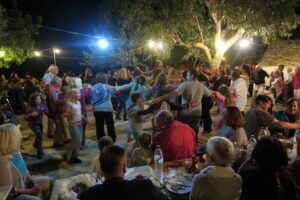 Greek Panigiri: A Feast for the Senses and the Soul
Greek Panigiri: A Feast for the Senses and the Soul
To truly feel the spirit of Greece, skip the guidebooks and find yourself at a panigiri—a traditional village festival where music, dancing, food, and community come together in one joyful celebration. Rooted in religious holidays and local saints’ feast days, panigiria (plural) are not just events—they’re an experience.
From the mountains of Epirus to the islands of the Cyclades, every village has its own way of celebrating. The heart of it all? Live music, typically led by the bouzouki or island violin, with singers belting out folk songs that everyone seems to know by heart. As the night deepens, the dancing begins, often in massive circles, with old and young linking arms and moving to the beat of centuries-old rhythms.
And then, there’s the food—long communal tables piled with grilled meats, homemade bread, feta, olives, and free-flowing local wine or tsipouro. You may even be offered a shot by a stranger before being pulled into the next round of dancing.
Panigiria often start in the early evening and go well into the early morning, especially in summer. It’s sweaty, loud, sometimes chaotic, and always full of warmth and welcome. Tourists are not only invited—they’re embraced. There’s no better way to witness Greek hospitality and local culture at its most unfiltered and alive.
Would you like a list of the most famous panigiria by region or when and where to attend one during your visit?
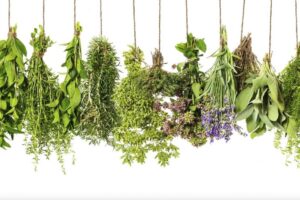 Greek Herbs & Chorta: Nature’s Pantry of the Mediterranean
Greek Herbs & Chorta: Nature’s Pantry of the Mediterranean
In Greece, nature is not just admired — it’s gathered, cooked, and celebrated. From wild mountain herbs to humble village greens, Greek cuisine is deeply rooted in the land and its natural bounty. Whether you’re enjoying a fragrant oregano-sprinkled salad or a plate of steamed chorta drizzled with lemon and olive oil, you’re tasting generations of wisdom and tradition.
Greek herbs like oregano, thyme, mint, dill, rosemary, and sage are essential to everyday cooking — adding depth, aroma, and healing properties to everything from grilled meats to simple vegetable dishes. They’re often picked fresh from the garden or dried in the sun on balconies and countryside fences.
Alongside these classic herbs is a lesser-known but much-loved staple of the Greek table: chorta — a collective term for wild greens foraged across hillsides, valleys, and olive groves. These greens vary by region and season, including dandelion, amaranth (vlita), purslane, sow thistle (zohos), nettle, and spiny chicory (stamnagathi). Often served boiled or steamed, then finished simply with olive oil and lemon, chorta is a dish that reflects the Greek way of life: modest, seasonal, healthy, and deeply connected to nature.
Beyond their flavor, herbs and chorta play a role in traditional medicine, fasting customs, and sustainable living — a quiet but powerful expression of the Mediterranean diet and the Greek philosophy of “less is more.”
Whether in a mountain village or a seaside taverna, Greece invites you to slow down, savor the greens, and taste the earth in every bite.
Would you like to experience collecting herbs and chorta with a local?










